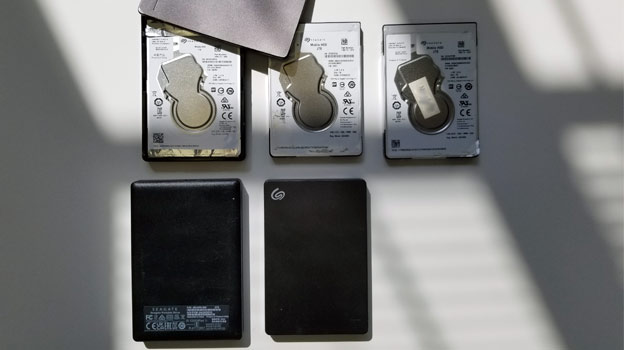
Seagate started manufacturing these drives several years ago. If you own a Seagate slim portable drive, the odds are that there is a Rosewood family hard drive inside.
You may think that this is pure speculation and that we are hating on the manufacturer for one reason or another, but I have to state here that what I am about to say is based entirely on my experience.
For starters, they are finicky. One wrong move, a slight bang, and the most likely result will be a mechanically-failed drive. You know, producing plenty of clicking, beeping, and a variety of other telltale noises you don’t want to hear coming out of your drive.
Fun Fact
Of all the drives we receive here for data recovery, 80 percent of them are Rosewoods. One reason might be because they are the most produced drive to date that Seagate makes. If you are thinking of buying a hard drive, it will most likely be a slim, portable Seagate. After all, small and compact is an attractive combination, so why not?
Plus, they are slightly cheaper than their competitors, at least by a couple of bucks, and really, a few dollars can make a difference. Especially when you consider how crazy prices have become in recent years. But also keep in mind that quality is often connected to price. As the Rosewoods are what I would classify as “affordable” drives, the cost saving to you may impact the quality of the product.
I’ll explain the quality of Rosewoods in a moment so you’ll know what I mean about that important factor.
So… what does a Rosewood drive look like? Here are a few drives, all of them are Rosewoods. The only way to properly identify a Rosewood is to pop open the plastic enclosure the drive sits within.

Fun Fact #2
Every second data recovery job that involves a Rosewood drive requires more than one donor. Sometimes that jumps to two or three donors. Remember, that occurs in 50 percent of the Rosewood recovery cases.
I have also noted a consistent pattern. I was going to originally refer to it as a “strange regularity” but a “consistent pattern” explains it better. Once the drive is opened, which in this case means just opened before any heads are removed or any other work has commenced, and the drive is left alone for a period, the heads inside will wear out and stop working.
It’s the strangest thing.
At first, I thought it was just a weird thing happening just once but then I noticed it was happening more frequently. It really had me puzzled. I can explain it by saying the Rosewoods act much like a helium-based drive in that, once you pop it open, they just stop working. Dead in the water.
This is why I call them cursed. That’s fine if you are into that sort of thing, but to me, it boils down to one simple fact: manufacturing. Good quality drives don’t normally do this. With that in mind, I conclude that Seagate is focused a bit more on quantity than quality. Or at least that’s how it appears with the Rosewood family of drives.
Sadly, as I’ve stated, the majority of Seagate drives are Rosewoods.
In conclusion, I’m going to say something that is probably not the best thing for a data recovery business to say, but I have to be honest about this situation. If you have data that you absolutely need to store in a safe place, your best bet is to register for a cloud account offered by a reputable company. At least that way, your data will be safe and secure and backed up regularly.
